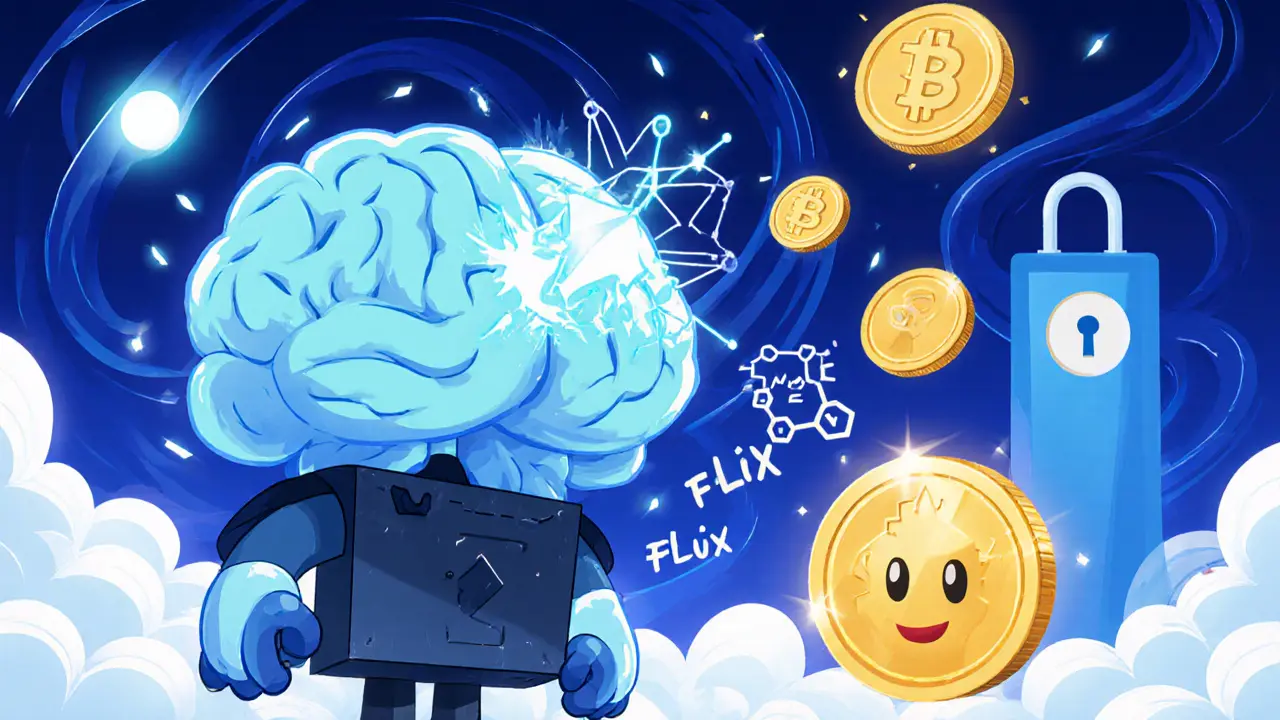
- 1 Mar 2025
- Elara Crowthorne
- 19
Flux (FLX) Token Utility Explorer
Explore how the FLX token powers the Flux decentralized cloud ecosystem through its three core roles:
Pay for Services
Developers use FLX to launch applications on FluxOS or purchase GPU time on FluxEdge.
Vote on Upgrades
FLX holders stake tokens in XDAO to vote on protocol improvements and upgrades.
Earn Rewards
Miners and node operators receive FLX rewards for contributing computing power to the network.
Token Usage Comparison
| Feature | Flux (Decentralized) | Traditional Cloud (AWS, Azure...) |
|---|---|---|
| Control | Community-run nodes, no single owner | Owned by a single corporation |
| Uptime Guarantee | 100% by design—no single point of failure | High, but outages happen |
| Pricing Model | Pay-per-use with FLX, market-driven | Fixed rates, often higher for peak demand |
| Data Sovereignty | Data spread across global nodes, resistant to censorship | Data stored in specific regions, subject to local law |
| Energy Use | Proof-of-Useful Work aligns mining with productive tasks | Data centers consume power without direct utility |
Consensus Mechanism: Proof-of-Useful Work (PoUW)
Unlike traditional Proof-of-Work that wastes energy on arbitrary computations, Flux uses Proof-of-Useful Work where miners solve real-world problems like:
- AI model training
- Scientific calculations
- Blockchain indexing
- Other productive computational tasks
This approach ensures that the energy consumed directly contributes to useful computing work, reducing environmental impact while maintaining network security.
Key Takeaway
The FLX token isn't just a speculative asset—it's integral to every aspect of the Flux network, from paying for compute resources to governing protocol changes to rewarding network participants.
People keep hearing about Flux cryptocurrency but aren’t sure what it actually does. In short, Flux (ticker FLX) is a digital coin that powers a fully decentralized cloud‑computing network. It lets developers run Web3 apps without relying on a single data center, and it rewards anyone who contributes CPU, GPU or storage power with fresh FLX tokens.
Understanding the Flux ecosystem
Flux is a decentralized cloud infrastructure platform launched in 2018. Its native asset, the FLX coin, fuels every activity on the network, from transaction fees to node staking.
The ecosystem consists of six tightly integrated pieces:
- FluxOS - a Linux‑based operating system that lets developers deploy containers on the Flux network as easily as pushing code to a cloud server.
- FluxNode - individual machines that donate computing power. Nodes are rewarded in FLX for completing work.
- Zelcore - a self‑custodial, multi‑asset wallet where users store FLX, other crypto and even NFTs.
- XDAO - the decentralized governance body that lets FLX holders vote on protocol upgrades.
- FluxEdge - a marketplace that matches high‑performance computing demand (AI, rendering, scientific modeling) with under‑used GPU resources.
- Flux blockchain - the base layer that records all transactions, governance votes and token movements.
All these parts work together to offer a truly permissionless cloud that anyone can tap into, without a single company controlling the hardware.
How the FLUX token powers the network
The FLX token is more than a speculative asset; it has three core roles:
- Utility: Developers pay FLX to launch and run workloads on FluxOS or to purchase GPU time on FluxEdge.
- Governance: Token holders lock their FLX in XDAO to vote on proposals; voting weight is proportional to the amount staked.
- Incentive: Miners and node operators earn a fixed block reward (currently 37.5 FLX) that halves roughly every 2.5 years, creating scarcity.
Because FLX is required for both paying for services and participating in governance, demand stays linked to real network usage, not just price speculation.

Consensus: Proof‑of‑Useful Work (PoUW)
Flux uses a hybrid mechanism that blends classic Proof‑of‑Work (PoW) with a useful‑work twist. Instead of hashing for the sake of hashing, miners solve real computational problems-like AI model training or scientific calculations-while securing the chain. This approach, called Proof‑of‑Useful Work, reduces wasted energy and gives miners a tangible product for their effort.
Node operators can also stake FLX without locking periods, unlike many PoS systems. The flexible staking model lowers the entry barrier and encourages broader participation.
Flux vs. traditional cloud services
At first glance, Flux looks like another cloud provider, but the differences are stark. Below is a quick side‑by‑side view.
| Feature | Flux (Decentralized) | Traditional Cloud (AWS, Azure…) |
|---|---|---|
| Control | Community‑run nodes, no single owner | Owned by a single corporation |
| Uptime guarantee | 100% by design-no single point of failure | High, but outages happen |
| Pricing model | Pay‑per‑use with FLX, market‑driven | Fixed rates, often higher for peak demand |
| Data sovereignty | Data spread across global nodes, resistant to censorship | Data stored in specific regions, subject to local law |
| Energy use | Proof‑of‑Useful Work aligns mining with productive tasks | Data centers consume power without direct utility |
The table shows why developers focused on security, censorship resistance, or lower cost might lean toward Flux.

Getting started with Flux
If you want to experiment, follow these steps:
- Download Zelcore for Windows, macOS, Linux, Android or iOS.
- Create a new wallet and back up the seed phrase securely.
- Buy a small amount of FLX on a reputable exchange (price around $0.20 as of Oct2025).
- Transfer the FLX to your Zelcore address.
- Navigate to the FluxOS dashboard inside Zelcore, choose a pre‑built Docker container, and deploy it with a few clicks.
- If you have spare CPU/GPU power, apply to become a FluxNode via the FluxOS portal; stake the required FLX collateral and start earning rewards.
Documentation is extensive, but a fresh user typically needs a week of hands‑on testing to become comfortable.
Market snapshot and future outlook
On October62025, FLX trades at roughly $0.199 with a 24‑hour volume of $6.5million. The network runs over 13,500 nodes, delivering more than 107,000 CPU cores and 7PB of storage. Analysts at Gate.com note that Flux’s blend of real‑world utility and sustainable mining makes it a compelling long‑term play.
Planned 2025 upgrades include Multisig FluxNodes for added security, the SSP wallet for smoother asset management, and FluxCore Beta, which promises faster block propagation. These road‑map items signal continued developer commitment and a growing ecosystem.
Critics point out the steep learning curve-understanding FluxOS, node staking, and PoUW can take time. Still, community sentiment remains largely positive, especially around the flexibility of staking and the genuine decentralization of the network.
Frequently Asked Questions
What is the main purpose of the FLX token?
FLX functions as a utility coin for paying compute resources, a governance token for voting in XDAO, and a reward for miners and node operators.
How does Proof‑of‑Useful Work differ from regular Proof‑of‑Work?
Instead of solving arbitrary hash puzzles, PoUW miners perform real tasks-like AI model training-so the energy spent directly contributes to useful computing work.
Can I run a FluxNode without technical expertise?
The setup Wizard in FluxOS guides you through hardware requirements, FLX staking, and software installation, making it possible for non‑developers to join.
Is Flux more secure than centralized cloud services?
Because data and compute are spread across thousands of independent nodes, there’s no single point of failure or attack, offering higher resilience against outages and censorship.
Where can I buy FLX?
FLX is listed on major exchanges such as Binance, KuCoin and Kraken. Always transfer to your Zelcore wallet for full functionality.

19 Comments
Hey folks, just wanted to say that the FLX token looks like a promising way to bring real compute power to the masses. It's kinda cool how the proof‑of‑useful‑work actually does something useful, instead of just burning electricity. If anyone's looking to dip their toe in, definitely check out the Zelcore wallet and the step‑by‑step guide they have-it's pretty straightforward. Happy to help if you have any questions, we’re all learning together!
Wow, this guide is super helpful! 😄 I love how FLX ties together utility, governance, and incentives all in one neat package. If you're just starting, grab the Zelcore app, snag a little FLX, and experiment with a tiny Docker container-you’ll get the hand of it in no time! 🚀 Keep pushing forward, you’ve got this! 💪
Oh sure, because rolling your own decentralized cloud is as easy as installing an app. The only thing missing is a magic wand to make all those nodes cooperate perfectly.
The whole FLX hype is just another way for foreign tech elites to push their agenda. Real American innovation should stay focused on proven infrastructure, not this untested decentralization nonsense.
While the enthusiasm is commendable, it is essential to approach the FLX ecosystem with a measured perspective; the volatility of the token, coupled with the technical barriers to node operation, may present challenges for newcomers, especially those without prior exposure to blockchain technologies. Nevertheless, leveraging community resources and thorough documentation can mitigate these concerns effectively.
To the untrained eye, Flux appears to be a legitimate advancement in decentralized computing. However, one must consider the hidden concentration of mining hardware in jurisdictions with lax regulations, which could jeopardize the purported decentralization.
Flux presents a fascinating blend of blockchain principles with practical cloud computing, which is a rare combination in the current crypto landscape. The proof‑of‑useful‑work mechanism stands out because it channels energy expenditure into tangible tasks such as AI model training, rather than merely solving hash puzzles. By doing so, the network not only secures itself but also contributes to real‑world computational demands, a win‑win scenario. Developers can leverage FLX to pay for compute resources on FluxOS, making deployment of decentralized applications more seamless than traditional cloud services. The governance model, embodied by XDAO, allows token holders to have a direct say in protocol upgrades, fostering a sense of community ownership. Incentives are aligned through block rewards that halve periodically, which creates scarcity while rewarding active contributors. The scalability of the network is aided by its global node distribution, reducing single points of failure and enhancing resilience. Moreover, the data sovereignty benefits are notable, as information is fragmented across multiple jurisdictions, mitigating censorship risks. Users can easily acquire FLX on major exchanges and move it into the Zelcore wallet for full functionality. The step‑by‑step onboarding process, while comprehensive, can appear daunting at first, but hands‑on experimentation quickly demystifies the system. Comparing Flux to traditional cloud providers highlights clear cost advantages, especially under peak demand scenarios where centralized services raise prices. Energy efficiency is another compelling factor, as PoUW ensures that mining contributes productively rather than wasting electricity. Community sentiment remains largely positive, despite some criticisms regarding the steep learning curve. Ongoing roadmap upgrades, such as multisig node support and faster block propagation, indicate a commitment to continuous improvement. In summary, Flux offers a compelling alternative for developers seeking decentralized, cost‑effective, and environmentally mindful computing solutions.
Yeah, sounds like a lot of hype for a few extra lines of code.
Behold, the digital tapestry of Flux unfolds like a phoenix rising from the ashes of burnt‑out server farms, each node a flickering ember of possibility. In the grand theatre of decentralization, FLX is the chorus that sings the anthem of freedom, while the audience-us, the curious wanderers-cheer for every GPU pulse that fuels a new AI masterpiece. Yet, beware the shadows where conspiracies lurk, whispering that the very clouds we trust may conceal unseen eyes.
If you’re new to Flux, start small: get a few FLX, install Zelcore, and try the sample Docker container they provide. This hands‑on step shows how the token pays for compute and how the network rewards you for contributing resources. Once you’re comfortable, you can explore the governance side by staking in XDAO and voting on proposals, which gives you a voice in the project’s future.
That’s great advice, but honestly the docs can be a bit overwhelming, especially when you’re juggling work and trying to understand PoUW. Still, I found the community forums helpful, and you don’t have to dive deep right away.
It is incumbent upon the discerning scholar to recognize that the Flux protocol epitomizes a paradigm shift within the realm of distributed computing. Such an evolution warrants rigorous academic scrutiny.
Sure, but did you ever think about who's really pulling the strings behind the scenes? I suspect some shadowy cabal is using the PoUW as a front to gather massive compute power for unknown purposes.
Flux’s tokenomics are sound; the halving schedule ensures scarcity while rewarding participants.
Indeed, the design aligns incentives effectively; however, it is advisable to monitor market dynamics closely to mitigate exposure.
Honestly, FLX is kinda dope, but you gotta watch out for the crazy volatility-one day it’s up, the next it’s down.
True, the swings can be wild, but that’s part of the excitement in crypto-just make sure you only invest what you can afford to lose.
From an architectural standpoint, Flux leverages container orchestration akin to Kubernetes, yet abstracts the underlying infrastructure through a decentralized consensus layer, thereby reducing latency overhead and enhancing fault tolerance.
Wow-what an insightful breakdown!!!; the technical depth is truly impressive!!!; I appreciate the thoroughness!!!